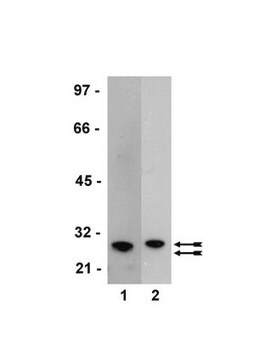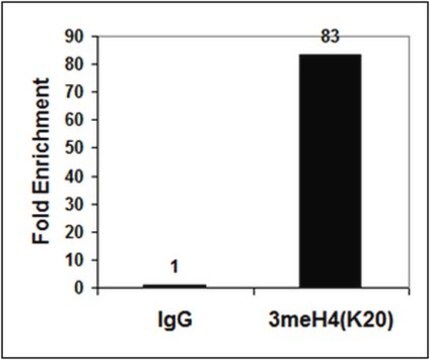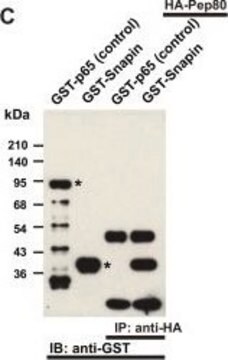04-079
Anty-trimetylo-histon H4 (Lys20), przeciwciało, królicze monoklonalne
culture supernatant, Upstate®
Synonim(y):
H4K20me3, histon H4 (tri metyl K20)
About This Item
Polecane produkty
pochodzenie biologiczne
rabbit
Poziom jakości
forma przeciwciała
culture supernatant
rodzaj przeciwciała
primary antibodies
klon
monoclonal
reaktywność gatunkowa
vertebrates, human
producent / nazwa handlowa
Upstate®
metody
ChIP: suitable
dot blot: suitable
western blot: suitable
izotyp
IgG
numer dostępu NCBI
numer dostępu UniProt
Warunki transportu
wet ice
docelowa modyfikacja potranslacyjna
trimethylation (Lys20)
informacje o genach
human ... H4C1(8359)
Opis ogólny
Specyficzność
Immunogen
Zastosowanie
Sonikowaną chromatynę przygotowaną z komórek HeLa (1 X 106 równoważników komórek na IP) poddano immunoprecypitacji chromatyny przy użyciu 10 µl supernatantu kontroli negatywnej lub przeciwciała anty-trimetylo-histonowego H4 (Lys20) i zestawu Magna ChIP A (nr kat. 17-610). Pomyślna immunoprecypitacja fragmentów DNA związanych z trimetylo-histonem H4 (Lys20) została zweryfikowana przez qPCR przy użyciu starterów ChIP B-Globin. Szczegółowe informacje dotyczące eksperymentu można znaleźć w protokole EZ-Magna ChIP A (nr kat. 17-408) lub EZ-ChIP (nr kat. 17-371).
Analiza Dot Blot: Absurance Histone H3 Antibody Specificity Array (nr kat. 16-667) i Absurance Histone H2A, H2B, H4 Antibody Specificity Array (nr kat. 16-665), które zawierają peptydy histonowe z różnymi modyfikacjami, były sondowane za pomocą Cat. 04-079, Anti-trimethyl Histone H4 (Lys20) (rozcieńczenie 1:500). Białka były wizualizowane przy użyciu anty-króliczej IgG osła sprzężonej z HRP i systemu detekcji chemiluminescencji.
Epigenetyka i funkcje jądrowe
Histony
Jakość
Opis wartości docelowych
Postać fizyczna
Przechowywanie i stabilność
Informacje prawne
Oświadczenie o zrzeczeniu się odpowiedzialności
Nie możesz znaleźć właściwego produktu?
Wypróbuj nasz Narzędzie selektora produktów.
Kod klasy składowania
12 - Non Combustible Liquids
Klasa zagrożenia wodnego (WGK)
WGK 1
Temperatura zapłonu (°F)
Not applicable
Temperatura zapłonu (°C)
Not applicable
Certyfikaty analizy (CoA)
Poszukaj Certyfikaty analizy (CoA), wpisując numer partii/serii produktów. Numery serii i partii można znaleźć na etykiecie produktu po słowach „seria” lub „partia”.
Masz już ten produkt?
Dokumenty związane z niedawno zakupionymi produktami zostały zamieszczone w Bibliotece dokumentów.
Nasz zespół naukowców ma doświadczenie we wszystkich obszarach badań, w tym w naukach przyrodniczych, materiałoznawstwie, syntezie chemicznej, chromatografii, analityce i wielu innych dziedzinach.
Skontaktuj się z zespołem ds. pomocy technicznej








